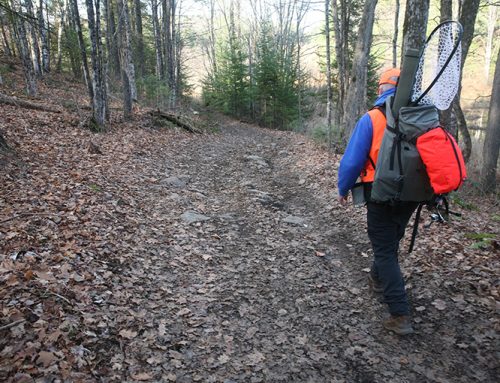
The Ministry of Natural Resources (MNR) has announced a proposal for a limited bear hunt for 8 wildlife management units (WMU) in northern Ontario.
Related reads
- Bear Attacks Spark Calls for Spring Hunt
- Bear Attack Highlights Need for Better Management
- Bear Action Needed, Not Committee
Ontario has proposed a 2-year bear management pilot program in WMUs 13, 14, 29, 30, 36, 39, 41 and 42, all of which have reported high levels of nuisance bear activity. Communities in and around these units include Timmins, Thunder Bay, Sudbury, Sault Ste. Marie and North Bay.
The hunt will only be open to Ontario residents and will take place from May 1 to June 15 in 2014 and 2015. Under the proposed pilot, hunting bear cubs or females with cubs would be illegal. The province will monitor and evaluate the success of this program on an ongoing basis.
“Since the cancellation of the spring bear hunt in 1999, the OFAH has been advocating for a return of the hunt and we are pleased that the provincial government has finally recognized the value of this valuable wildlife management tool and has proposed a bear management program in response to problem bears in northern Ontario,” said Angelo Lombardo, executive director of the Ontario Federation of Anglers and Hunters. “While this is not the restoration of a full spring hunt, it is a positive start, and the OFAH looks forward to working with the provincial government and local municipalities so that the full benefits of regulated hunting can be realized.”
Each municipal council will have to pass a resolution agreeing to opt-in to the program. The province intends to continue to work with municipalities on ways to limit human/bear conflict.
“Public safety is paramount and Ontarians should feel safe in their communities,” said Minister of Natural Resources David Orazietti. “We have heard increasingly from some northern Ontario municipalities that they are concerned about public safety and human-bear conflicts. In response, we are taking action in a strategic way to address the areas of highest incidence.”






bear hunting using baited stands is a joke…! bmu’s are not fair… hunt bears .. but not with baited stands…
people don’t call bear wise because of the crap you hear for the ops who don’t live in the north like did you clean your bbq that day my sons who where 8 and 5 could not get in the house and had to run across the street there was 3 bears in my yard but it ok because it was our fault we live in the north i grew up here lived in th bush never feared bear till the spring was gone now all year have a 12ga slug gun
with me but hey it safe in the south so it ok
Kevin Cameron,
This proposed bear “hunt” isnt a hunt for sport. Its about managing the black bears and trying to reduce the numbers back to sustainable levels while hoping to achieve less bear/human conflicts and encounters.
Using baits to bring bears in close is very beneficial actually. If the hunter has a good view of a bear at his bait, this leaves him plenty of time to view the animal and be sure there are no cubs around, and to be certain he or she is shooting a male bear (Which is what we are after). Hunters who are very anxious to shoot a bear, might spot one out in a clear cut for example, and be so excited they will shoot the first one they see. And maybe that bear was a female with young cubs in the bush behind her. And there isn’t a single respectable outdoorsman out there who wants to orphan black bear cubs.
This is why bait sites are very beneficial in the selective spring bear harvest. Myself as well as others I’m sure are excited for the upcoming hunt as a way to get out in the great outdoors during the spring, and put some delicious meat in the freezer at the same time. All while enjoying our heritage, and maintaining a healthy population of bears without letting them grow out of control like we have been in the past decade.
I hope you find a way to get out in the wilderness and enjoy the great pass time many of us partake in year after year!!
roger….. I have probably seen more bears up close than you can dream of… having spent most of my career living in tents all across Canada.. and hiking up to 20 miles each day through bear country, un-armed.
I am just saying … don’t try calling bear hunting a sport… it’s a cull… and I have no problem with that…. just don’t pretend it’s a sport… (well not much of one any way….)
Shoot and eat all the bears you want…. np…
And I also love trees…. you should try hugging one… some time… better than getting it up the stump…. :)
I was wondering out of the 2011 harvest rate of 5,347, how many where taken by resident hunters versus non-hunters? Fall hunting is really good so why didn’t the residents take advantage all these years? In the fall, at least the cubs are more visible to the hunter and a breeding aged sow is easier to pick out.(pass her up if you have hunter ethics)
I have to disagree with your letter and propsal.
I feel that you are not interested in protecting our wildlife as you are in trying to satisfy hunters. There is no way you can control mother bears with cubs from being killed. 1) they don’t take their little ones with them when they are small;2) hunters are certainly not going to bother to find out if there are cubs. As far as nuisance bears, watch your garbage and stop with the bear/moose killing issues. This is nature. Bear also die naturally, they get killed on highways, killed in fights . Being slaughtered for profit just to appease some should not be another reason for these beautiful creatures to die and their little ones to starve to death. If we don’t respect our wildfire it will be gone .No need for a spring bear hunt!